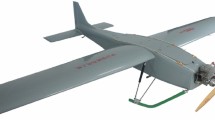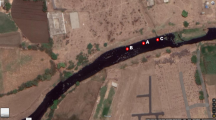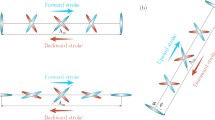Abstract
A geometric dynamic modeling framework for generic multirotor aerial vehicles (MAV), based on a modern Lie group formulation of classical screw theory, is presented. Our framework allows for a broad range of rotor-wing configurations: any number of rotors can be attached in arbitrary configurations to either the body or wings, with the rotors and wings also tiltable. Our framework takes into account all masses and inertias of the MAV body and rotors, and accounts for both rotor thrust forces and moments as well as external aerodynamic and other forces. Compared to existing methods, our Lie group framework possesses several practical advantages useful for applications ranging from design optimization to model identification and trajectory optimization: (1) the dynamic equations can be easily transformed to coordinates of any reference frame; (2) kinematic and mass–inertial parameters can be easily factored from the dynamic equations; (3) exact, closed-form analytic derivatives of the dynamics with respect to the configuration variables are easily derived. We demonstrate our systematic modeling procedure on examples of fixed-tilt, variable-tilt and hybrid MAVs with wings.










Similar content being viewed by others
Data availability statements:
Data sharing is not applicable to this article as no datasets were generated or analyzed during the current study.
Change history
14 March 2022
A Correction to this paper has been published: https://doi.org/10.1007/s11071-022-07299-5
Notes
Most textbooks contribute this theorem only to the work of M. Chasles in 1830; however, it dates back to G. Mozzi in 1763.
Although one has that \((\mathbb {R}^{6})^*\cong \mathbb {R}^{6}\), we denote in this work the space of wrenches by \((\mathbb {R}^{6})^*\) to stress their covector nature which is crucial to note as wrenches and twists change coordinates differently.
Abbreviations
- \(\{{a}\}\) :
-
Reference frame a
- \(\varvec{T}_{a}^{b} \in \text {SE(3)}\) :
-
Relative configuration of \(\{{a}\}\) w.r.t. \(\{{b}\}\)
- \(\varvec{R}_{a}^{b} \in \text {SO(3)}\) :
-
Relative orientation of \(\{{a}\}\) w.r.t. \(\{{b}\}\)
- \(\varvec{p}_{a}^{b} \in \mathbb {R}^{3}\) :
-
Position of the origin of \(\{{a}\}\) expressed in \(\{{b}\}\)
- \({[}\varvec{x}{]} \in \text {so}(3)\) :
-
Skew-symmetric \(3\times 3\) matrix representation of \(\varvec{x}\in \mathbb {R}^{3}\)
- \(\varvec{\mathcal {V}}_{a}^{c,b} \in \mathbb {R}^{6}\) :
-
Twist (generalized velocity) of \(\{{a}\}\) w.r.t. \(\{{b}\}\) expressed in \(\{{c}\}\)
- \(\varvec{\omega }_{a}^{c,b}, \in \mathbb {R}^{3}\) :
-
The angular part of the twist \(\varvec{\mathcal {V}}_{a}^{c,b}\)
- \(\varvec{v}_{a}^{c,b}\in \mathbb {R}^{3}\) :
-
The linear part of the twist \(\varvec{\mathcal {V}}_{a}^{c,b}\)
- \({[}\varvec{\mathcal {V}}{]} \in \text {se}(3)\) :
-
The \(4\times 4\) matrix representation of the twist \(\varvec{\mathcal {V}}\in \mathbb {R}^{6}\)
- \(\varvec{\mathcal {S}}_{a}^{c,b} \in \mathbb {R}^{6}\) :
-
The screw-vector corresponding to a unit twist between the bodies attached to \(\{{a}\}\) and \(\{{b}\}\), expressed in \(\{{c}\}\)
- \(\varvec{\mathcal {W}}_{\text {src}}^{c,b} \in (\mathbb {R}^{6})^*\) :
-
The applied wrench by the source (src) to the body associated with \(\{{b}\}\), expressed in \(\{{c}\}\)
- \(\varvec{m}_{\text {src}}^{c,b} \in (\mathbb {R}^{3})^*\) :
-
The moment part of the wrench \(\varvec{\mathcal {W}}_{\text {src}}^{c,b}\)
- \(\varvec{f}_{\text {src}}^{c,b} \in (\mathbb {R}^{3})^*\) :
-
The force part of the wrench \(\varvec{\mathcal {W}}_{\text {src}}^{c,b}\)
- \(\varvec{\mathcal {G}}_{b}^{c} \in \mathbb {R}^{6\times 6}\) :
-
The generalized inertia tensor of the body associated with \(\{{b}\}\), expressed in \(\{{c}\}\)
References
Baranek, R., Šolc, F.: Modelling and control of a hexa-copter. In: 2012 13th International Carpathian Control Conference (ICCC), pp. 19–23. IEEE (2012)
Bouabdallah, S., Murrieri, P., Siegwart, R.: Design and control of an indoor micro quadrotor. In: 2004 IEEE International Conference on Robotics and Automation, 2004. Proceedings. ICRA’04, vol. 5, pp. 4393–4398. IEEE (2004)
Bouabdallah, S., Murrieri, P., Siegwart, R.: Design and control of an indoor micro quadrotor. In: IEEE International Conference on Robotics, vol. 5, pp. 4393–4398 (2004)
Brescianini, D., D’Andrea, R.: Design, modeling and control of an omni-directional aerial vehicle. In: 2016 IEEE International Conference on Robotics and Automation (ICRA), pp. 3261–3266. IEEE (2016)
Califano, F., Rashad, R., Dijkshoorn, A., Groot Koerkamp, L., Sneep, R., Brugnoli, A., Stramigioli, S.: Decoding and realising flapping flight with port-hamiltonian system theory. Annual Reviews in Control (to be published) (2021)
Çetinsoy, E., Dikyar, S., Hançer, C., Oner, K., Sirimoglu, E., Unel, M., Aksit, M.: Design and construction of a novel quad tilt-wing uav. Mechatronics 22(6), 723–745 (2012)
Cheviron, T., Chriette, A., Plestan, F.: Generic nonlinear model of reduced scale uavs. In: IEEE International Conference on Robotics and Automation, 2009. ICRA’09, pp. 3271–3276. IEEE (2009)
Duindam, V., Macchelli, A., Stramigioli, S., Bruyninckx, H.: Modeling and control of complex physical systems: the port-Hamiltonian approach. Springer Science & Business Media (2009)
Elfeky, M., Elshafei, M., Saif, A.W.A., Al-Malki, M.F.: Modeling and simulation of quadrotor uav with tilting rotors. Int. J. Control Autom. Syst. 14(4), 1047–1055 (2016)
Etkin, B., Reid, L.D.: Dynamics of Flight: Stability and Control. Wiley, New York (1996)
Ferrell, P., Smith, B., Stark, B., Chen, Y.: Dynamic flight modeling of a multi-mode flying wing quadrotor aircraft. In: 2013 International Conference on Unmanned Aircraft Systems (ICUAS), pp. 398–404. IEEE (2013)
Hamel, T., Mahony, R., Lozano, R., Ostrowski, J.: Dynamic modelling and configuration stabilization for an X4-flyer. IFAC Proceedings Volumes 35(1), 217–222 (2002)
Hoffmann, G., Huang, H., Waslander, S., Tomlin, C.: Quadrotor helicopter flight dynamics and control: theory and experiment. In: AIAA Guidance, Navigation and Control Conference and Exhibit, p. 6461 (2007)
Hoffmann, G., Huang, H., Waslander, S., Tomlin, C.: Quadrotor helicopter flight dynamics and control: theory and experiment. In: Guidance, Navigation, and Control and Co-located Conference American Institute of Aeronautics and Astronautics (2007)
Jiang, Q., Mellinger, D., Kappeyne, C., Kumar, V.: Analysis and synthesis of multi-rotor aerial vehicles. In: ASME 2011 International Design Engineering Technical Conferences and Computers and Information in Engineering Conference, pp. 711–720. American Society of Mechanical Engineers (2011)
Lee, S.H., Kim, J., Park, F., Kim, M., Bobrow, J.: Newton-type algorithms for dynamics-based robot movement optimization. IEEE Trans. Rob. 21(4), 657–667 (2005). https://doi.org/10.1109/TRO.2004.842336
Lynch, K.M., Park, F.C.: Modern Robotics. Cambridge University Press, Cambridge (2017)
Madani, T., Benallegue, A.: Backstepping control for a quadrotor helicopter. In: 2006 IEEE/RSJ International Conference on Intelligent Robots and Systems, pp. 3255–3260. IEEE (2006)
Madani, T., Benallegue, A.: Backstepping control for a quadrotor helicopter. In: IEEE/RSJ International Conference on Intelligent Robots and Systems, pp. 3255–3260 (2006)
Murray, R.M., Li, Z., Sastry, S.S.: A Mathematical Introduction to Robotic Manipulation. CRC Press, London (1994)
Park, F.C., Bobrow, J.E., Ploen, S.R.: A lie group formulation of robot dynamics. Int. J. Robot. Res. 14(6), 609–618 (1995)
Park, F.C., Kim, B., Jang, C., Hong, J.: Geometric algorithms for robot dynamics: a tutorial review. Appl. Mech. Rev. 70(1), 010,803 (2018)
Park, S., Her, J., Kim, J., Lee, D.: Design, modeling and control of omni-directional aerial robot. In: 2016 IEEE/RSJ International Conference on Intelligent Robots and Systems (IROS), pp. 1570–1575. IEEE (2016)
Rashad, R.: Energy-based modeling and control of interactive aerial robots: a geometric port-hamiltonian approach. Ph.D. thesis, University of Twente (2021)
Rashad, R., Califano, F., Stramigioli, S.: Port-hamiltonian passivity-based control on se (3) of a fully actuated uav for aerial physical interaction near-hovering. IEEE Robot. Autom. Lett. 4(4), 4378–4385 (2019)
Rashad, R., Engelen, J.B., Stramigioli, S.: Energy tank-based wrench/impedance control of a fully-actuated hexarotor: a geometric port-hamiltonian approach. In: 2019 International Conference on Robotics and Automation (ICRA), pp. 6418–6424. IEEE (2019)
Rashad, R., Goerres, J., Aarts, R.G., Engelen, J.B., Stramigioli, S.: Fully actuated multirotor UAVs: a literature review. IEEE Robot. Autom. Mag. 27(3), 97–107 (2020)
Ryll, M., Bülthoff, H.H., Giordano, P.R.: Modeling and control of a quadrotor uav with tilting propellers. In: 2012 IEEE International Conference on Robotics and Automation (ICRA), pp. 4606–4613. IEEE (2012)
Saif, A.W.A.: Feedback linearisation control of quadrotor with tiltable rotors under wind gusts. Int. J. Adv. Appl. Sci. 4(10), 150–159 (2017)
Saif, A.W.A., Aliyu, A., Al Dhaifallah, M., Elshafei, M.: Decentralized backstepping control of a quadrotor with tilted-rotor under wind gusts. Int. J. Control Autom. Syst. 16(5), 2458–2472 (2018)
Sámano, A., Castro, R., Lozano, R., Salazar, S.: Modeling and stabilization of a multi-rotor helicopter. J. Intell. Robot. Syst. 69(1–4), 161–169 (2013)
Stevens, B.L., Lewis, F.L., Johnson, E.N.: Aircraft Control and Simulation: Dynamics, Controls Design, and Autonomous Systems. Wiley, New York (2015)
Stramigioli, S.: Modeling and IPC Control of Interactive Mechanical Systems—A Coordinate-Free Approach. Springer, London (2001)
Tognon, M., Franchi, A.: Omnidirectional aerial vehicles with unidirectional thrusters: theory, optimal design, and control. IEEE Robot. Autom. Lett. 3(3), 2277–2282 (2018)
Visser, M., Stramigioli, S., Heemskerk, C.: Cayley-hamilton for roboticists. In: 2006 IEEE/RSJ International Conference on Intelligent Robots and Systems, pp. 4187–4192. IEEE (2006)
Acknowledgements
This work was partially supported by the PortWings project funded by the European Research Council [Grant Agreement No. 787675].
Author information
Authors and Affiliations
Corresponding author
Ethics declarations
Conflict of interest:
The authors declare that they have no conflict of interest.
Additional information
Publisher's Note
Springer Nature remains neutral with regard to jurisdictional claims in published maps and institutional affiliations.
Rights and permissions
About this article
Cite this article
Hong, Y., Rashad, R., Noh, S. et al. A geometric formulation of multirotor aerial vehicle dynamics. Nonlinear Dyn 107, 495–513 (2022). https://doi.org/10.1007/s11071-021-07042-6
Received:
Accepted:
Published:
Issue Date:
DOI: https://doi.org/10.1007/s11071-021-07042-6




